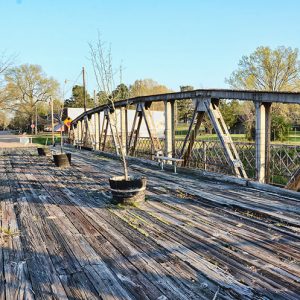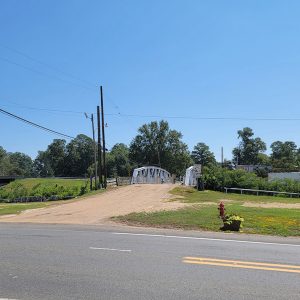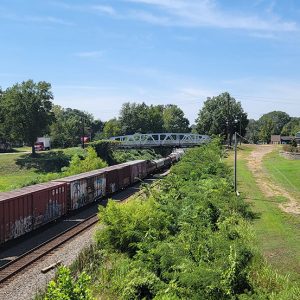calsfoundation@cals.org
Arkansas Highway 57 Bridge
The Arkansas Highway 57 Bridge crosses railroad tracks in Stephens (Ouachita County). Constructed in 1928, the bridge is a Warren pony truss with a pedestrian walkway located on the outside of the superstructure. It was listed on the National Register of Historic Places on September 28, 2005. Once used for vehicular traffic, it later became a pedestrian bridge.
Stephens was founded as a stop on the St. Louis, Arkansas and Texas Railway. The St. Louis Southwestern Railway, also known as the Cotton Belt, took control of the line after 1882. With a 160-acre plot to construct a settlement, the owners of the rail line convinced several business owners in nearby Richland (Ouachita County) to move to the new settlement in 1883. The quick growth of the town led to the closure of the Richland Post Office the same year and the opening of a new one in Stephens. The town was incorporated in 1889.
The railroad remained an important part of the community as the town grew. With the railroad bisecting the town, a bridge became a necessary safety feature to cross the tracks. At least one reference mentions a bridge large enough to accommodate both vehicular and pedestrian traffic in the site in 1890. The present bridge was constructed in 1928 as part of a state highway project begun the previous year. The work included a number of grading and drainage projects between southwest Camden (Ouachita County) and Stephens.
Warren truss bridges utilize equilateral or isosceles triangles to support the weight of objects on the bridge. The Arkansas Highway 57 Bridge is constructed from steel beams and rests on concrete abutments. The decking of the bridge is wood. Piers are not used to support the weight of the structure as it crosses two railroad tracks. The bridge is ninety-eight feet long and thirty-three feet wide.
The bridge is notable for two design features. It utilizes a polygonal top chord rather than a more typical straight chord. It is the only known example of this design on a state highway in Arkansas. The other notable feature is the presence of exterior walkways on both sides of the bridge, which allow pedestrians to cross while being protected from vehicles. An additional railing constructed from steel latticework protects pedestrians from the edge of the bridge. This is the only known example of such a walkway in Arkansas.
Originally constructed to carry travelers on Arkansas Highway 57, also known as Ruby Street, across the tracks, the bridge remained in use for decades. A new bridge was constructed in 2000–2001 to the north of the structure to carry Highway 57 traffic. The original wood decking of the Arkansas Highway 57 Bridge has been replaced, but otherwise the bridge remains much the same as it did when it opened. Benches have been placed on the bridge, and vehicles are no longer allowed to access this pedestrian bridge.
For additional information:
“Arkansas Highway 57 Bridge.” National Register of Historic Places registration form. On file at Arkansas Historic Preservation Program, Little Rock, Arkansas. Online at https://www.arkansasheritage.com/arkansas-historic-preservation-program (accessed May 28, 2024).
David Sesser
Henderson State University
 Early Twentieth Century, 1901 through 1940
Early Twentieth Century, 1901 through 1940 Historic Preservation
Historic Preservation Transportation
Transportation Arkansas Highway 57 Bridge
Arkansas Highway 57 Bridge  Arkansas Highway 57 Bridge
Arkansas Highway 57 Bridge  Arkansas Highway 57 Bridge
Arkansas Highway 57 Bridge  Arkansas Highway 57 Bridge
Arkansas Highway 57 Bridge  Arkansas Highway 57 Bridge View
Arkansas Highway 57 Bridge View 



Comments
No comments on this entry yet.